Financial Reporting: Users, Standards, Statements and Analysis Report
VerifiedAdded on 2019/12/03
|13
|3786
|491
Report
AI Summary
This finance report provides a comprehensive overview of financial reporting, examining the various users of financial statements, such as banks, investors, and regulatory bodies, and their respective needs. It delves into the influence of regulatory bodies like IASB and UK GAAP on the preparation of financial statements, emphasizing the importance of uniformity and compliance with accounting standards. The report assesses the implications for users within the conceptual framework, including key assumptions like going concern and consistency. It then explains the reporting standards that businesses must adhere to. The report further includes practical examples, such as preparing financial statements from incomplete records and consolidating statements for subsidiary and holding companies. It also covers ratio analysis, interpreting key financial ratios like gearing, earnings per share, and price-earnings ratio. The report concludes with a summary of the key findings and references used throughout the analysis.

FINANCE
1 | P a g e
1 | P a g e
Paraphrase This Document
Need a fresh take? Get an instant paraphrase of this document with our AI Paraphraser
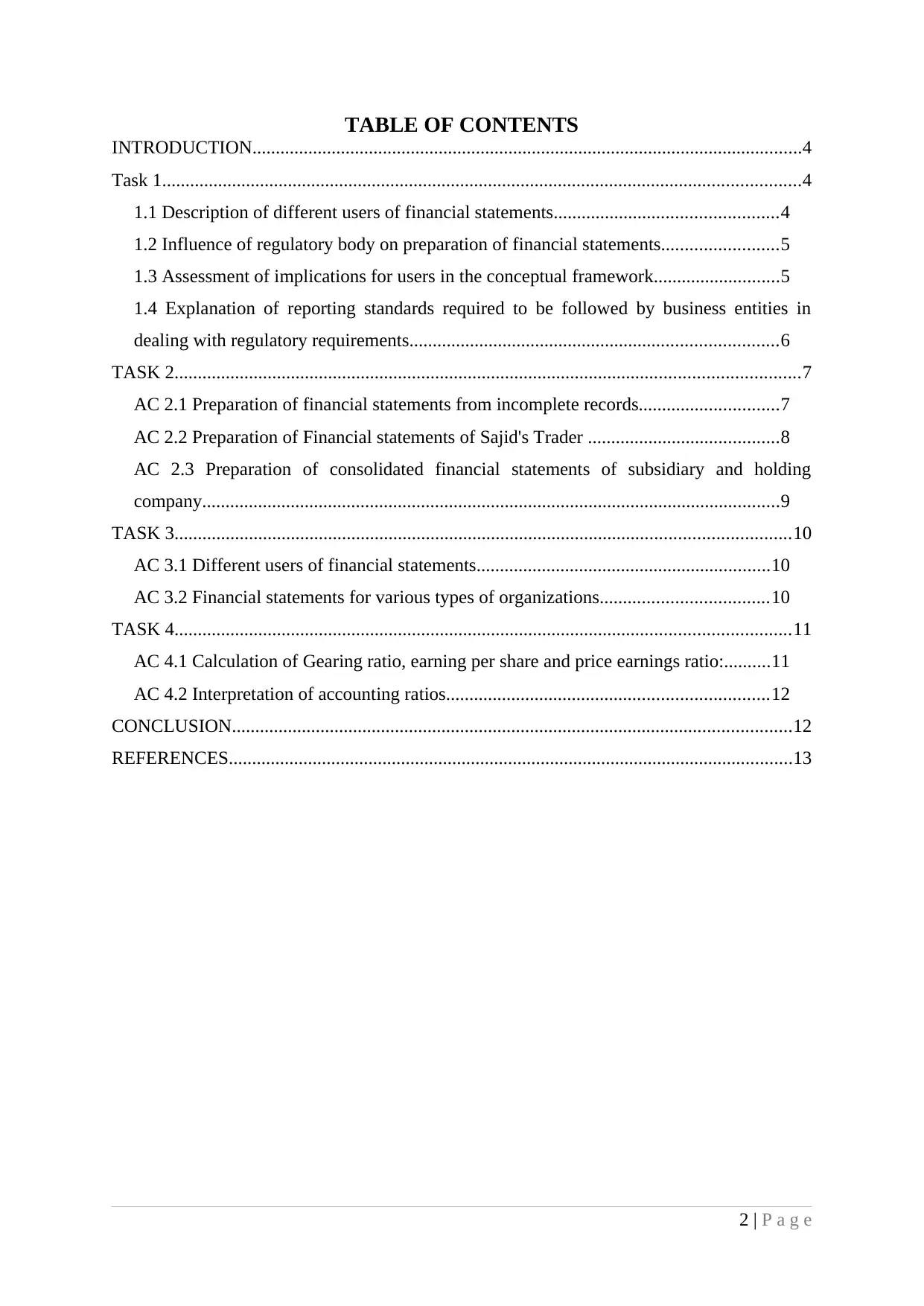
TABLE OF CONTENTS
INTRODUCTION......................................................................................................................4
Task 1.........................................................................................................................................4
1.1 Description of different users of financial statements................................................4
1.2 Influence of regulatory body on preparation of financial statements.........................5
1.3 Assessment of implications for users in the conceptual framework...........................5
1.4 Explanation of reporting standards required to be followed by business entities in
dealing with regulatory requirements...............................................................................6
TASK 2......................................................................................................................................7
AC 2.1 Preparation of financial statements from incomplete records..............................7
AC 2.2 Preparation of Financial statements of Sajid's Trader .........................................8
AC 2.3 Preparation of consolidated financial statements of subsidiary and holding
company............................................................................................................................9
TASK 3....................................................................................................................................10
AC 3.1 Different users of financial statements...............................................................10
AC 3.2 Financial statements for various types of organizations....................................10
TASK 4....................................................................................................................................11
AC 4.1 Calculation of Gearing ratio, earning per share and price earnings ratio:..........11
AC 4.2 Interpretation of accounting ratios.....................................................................12
CONCLUSION........................................................................................................................12
REFERENCES.........................................................................................................................13
2 | P a g e
INTRODUCTION......................................................................................................................4
Task 1.........................................................................................................................................4
1.1 Description of different users of financial statements................................................4
1.2 Influence of regulatory body on preparation of financial statements.........................5
1.3 Assessment of implications for users in the conceptual framework...........................5
1.4 Explanation of reporting standards required to be followed by business entities in
dealing with regulatory requirements...............................................................................6
TASK 2......................................................................................................................................7
AC 2.1 Preparation of financial statements from incomplete records..............................7
AC 2.2 Preparation of Financial statements of Sajid's Trader .........................................8
AC 2.3 Preparation of consolidated financial statements of subsidiary and holding
company............................................................................................................................9
TASK 3....................................................................................................................................10
AC 3.1 Different users of financial statements...............................................................10
AC 3.2 Financial statements for various types of organizations....................................10
TASK 4....................................................................................................................................11
AC 4.1 Calculation of Gearing ratio, earning per share and price earnings ratio:..........11
AC 4.2 Interpretation of accounting ratios.....................................................................12
CONCLUSION........................................................................................................................12
REFERENCES.........................................................................................................................13
2 | P a g e
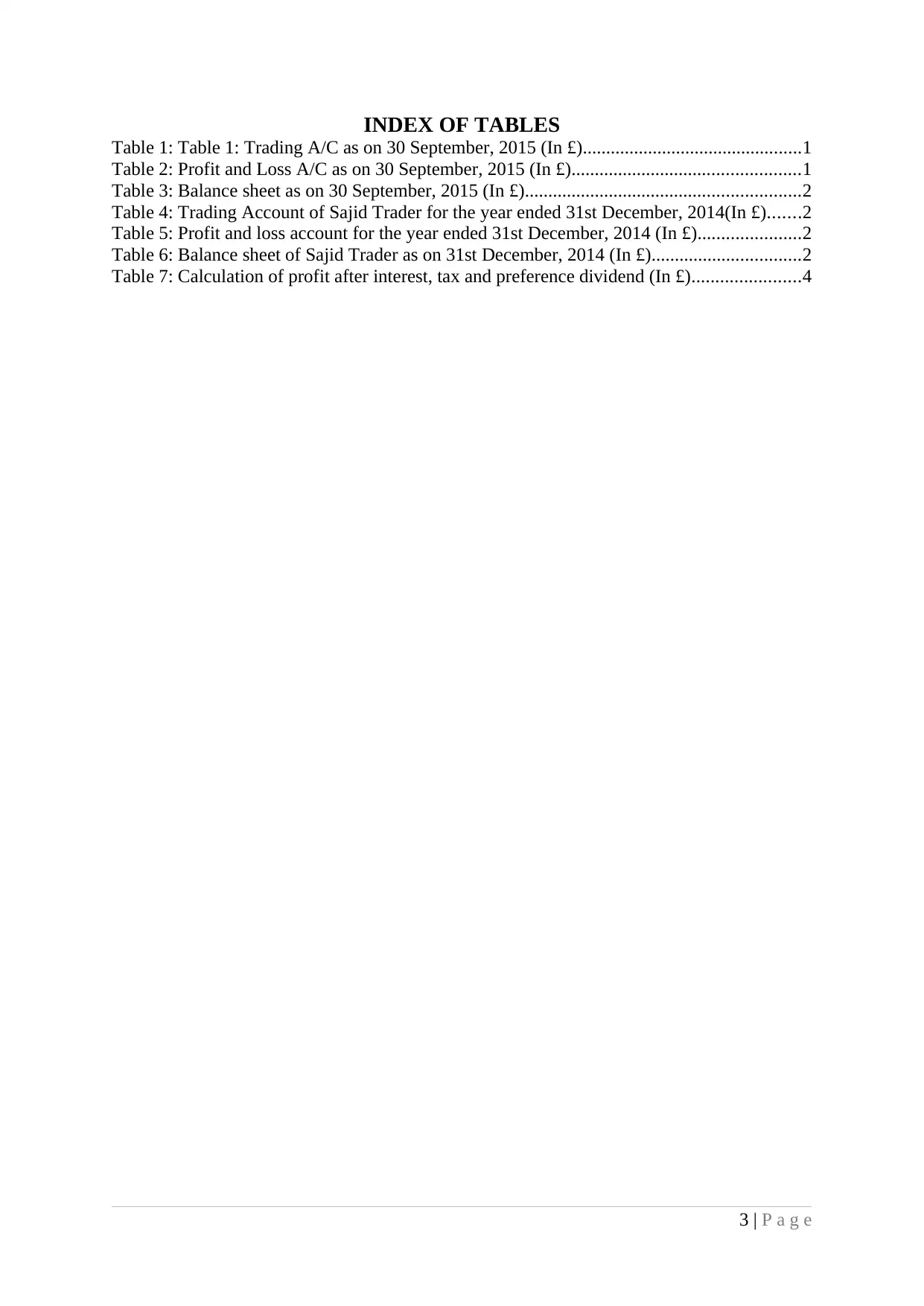
INDEX OF TABLES
Table 1: Table 1: Trading A/C as on 30 September, 2015 (In £)...............................................1
Table 2: Profit and Loss A/C as on 30 September, 2015 (In £).................................................1
Table 3: Balance sheet as on 30 September, 2015 (In £)...........................................................2
Table 4: Trading Account of Sajid Trader for the year ended 31st December, 2014(In £).......2
Table 5: Profit and loss account for the year ended 31st December, 2014 (In £)......................2
Table 6: Balance sheet of Sajid Trader as on 31st December, 2014 (In £)................................2
Table 7: Calculation of profit after interest, tax and preference dividend (In £).......................4
3 | P a g e
Table 1: Table 1: Trading A/C as on 30 September, 2015 (In £)...............................................1
Table 2: Profit and Loss A/C as on 30 September, 2015 (In £).................................................1
Table 3: Balance sheet as on 30 September, 2015 (In £)...........................................................2
Table 4: Trading Account of Sajid Trader for the year ended 31st December, 2014(In £).......2
Table 5: Profit and loss account for the year ended 31st December, 2014 (In £)......................2
Table 6: Balance sheet of Sajid Trader as on 31st December, 2014 (In £)................................2
Table 7: Calculation of profit after interest, tax and preference dividend (In £).......................4
3 | P a g e
⊘ This is a preview!⊘
Do you want full access?
Subscribe today to unlock all pages.

Trusted by 1+ million students worldwide
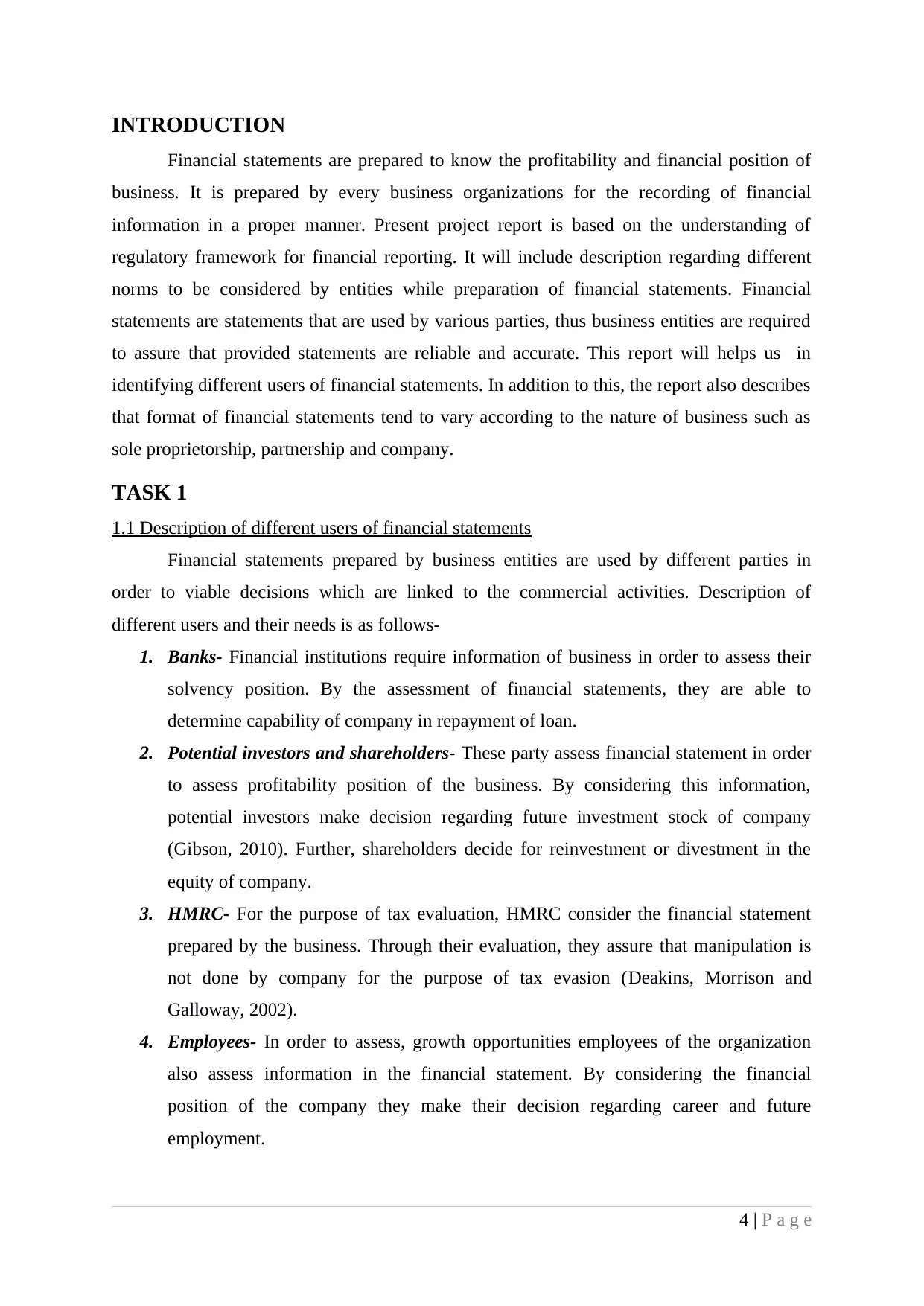
INTRODUCTION
Financial statements are prepared to know the profitability and financial position of
business. It is prepared by every business organizations for the recording of financial
information in a proper manner. Present project report is based on the understanding of
regulatory framework for financial reporting. It will include description regarding different
norms to be considered by entities while preparation of financial statements. Financial
statements are statements that are used by various parties, thus business entities are required
to assure that provided statements are reliable and accurate. This report will helps us in
identifying different users of financial statements. In addition to this, the report also describes
that format of financial statements tend to vary according to the nature of business such as
sole proprietorship, partnership and company.
TASK 1
1.1 Description of different users of financial statements
Financial statements prepared by business entities are used by different parties in
order to viable decisions which are linked to the commercial activities. Description of
different users and their needs is as follows-
1. Banks- Financial institutions require information of business in order to assess their
solvency position. By the assessment of financial statements, they are able to
determine capability of company in repayment of loan.
2. Potential investors and shareholders- These party assess financial statement in order
to assess profitability position of the business. By considering this information,
potential investors make decision regarding future investment stock of company
(Gibson, 2010). Further, shareholders decide for reinvestment or divestment in the
equity of company.
3. HMRC- For the purpose of tax evaluation, HMRC consider the financial statement
prepared by the business. Through their evaluation, they assure that manipulation is
not done by company for the purpose of tax evasion (Deakins, Morrison and
Galloway, 2002).
4. Employees- In order to assess, growth opportunities employees of the organization
also assess information in the financial statement. By considering the financial
position of the company they make their decision regarding career and future
employment.
4 | P a g e
Financial statements are prepared to know the profitability and financial position of
business. It is prepared by every business organizations for the recording of financial
information in a proper manner. Present project report is based on the understanding of
regulatory framework for financial reporting. It will include description regarding different
norms to be considered by entities while preparation of financial statements. Financial
statements are statements that are used by various parties, thus business entities are required
to assure that provided statements are reliable and accurate. This report will helps us in
identifying different users of financial statements. In addition to this, the report also describes
that format of financial statements tend to vary according to the nature of business such as
sole proprietorship, partnership and company.
TASK 1
1.1 Description of different users of financial statements
Financial statements prepared by business entities are used by different parties in
order to viable decisions which are linked to the commercial activities. Description of
different users and their needs is as follows-
1. Banks- Financial institutions require information of business in order to assess their
solvency position. By the assessment of financial statements, they are able to
determine capability of company in repayment of loan.
2. Potential investors and shareholders- These party assess financial statement in order
to assess profitability position of the business. By considering this information,
potential investors make decision regarding future investment stock of company
(Gibson, 2010). Further, shareholders decide for reinvestment or divestment in the
equity of company.
3. HMRC- For the purpose of tax evaluation, HMRC consider the financial statement
prepared by the business. Through their evaluation, they assure that manipulation is
not done by company for the purpose of tax evasion (Deakins, Morrison and
Galloway, 2002).
4. Employees- In order to assess, growth opportunities employees of the organization
also assess information in the financial statement. By considering the financial
position of the company they make their decision regarding career and future
employment.
4 | P a g e
Paraphrase This Document
Need a fresh take? Get an instant paraphrase of this document with our AI Paraphraser
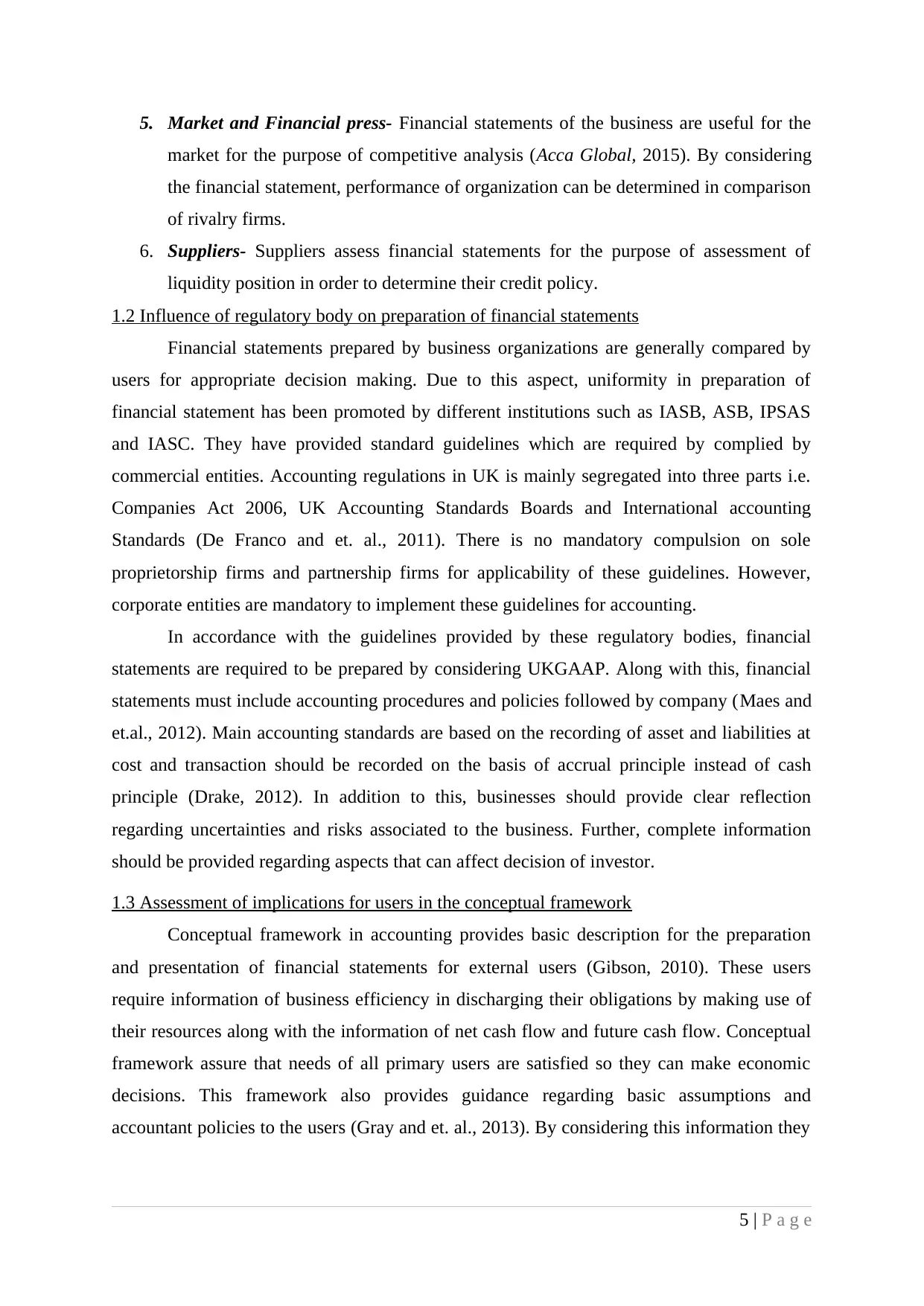
5. Market and Financial press- Financial statements of the business are useful for the
market for the purpose of competitive analysis (Acca Global, 2015). By considering
the financial statement, performance of organization can be determined in comparison
of rivalry firms.
6. Suppliers- Suppliers assess financial statements for the purpose of assessment of
liquidity position in order to determine their credit policy.
1.2 Influence of regulatory body on preparation of financial statements
Financial statements prepared by business organizations are generally compared by
users for appropriate decision making. Due to this aspect, uniformity in preparation of
financial statement has been promoted by different institutions such as IASB, ASB, IPSAS
and IASC. They have provided standard guidelines which are required by complied by
commercial entities. Accounting regulations in UK is mainly segregated into three parts i.e.
Companies Act 2006, UK Accounting Standards Boards and International accounting
Standards (De Franco and et. al., 2011). There is no mandatory compulsion on sole
proprietorship firms and partnership firms for applicability of these guidelines. However,
corporate entities are mandatory to implement these guidelines for accounting.
In accordance with the guidelines provided by these regulatory bodies, financial
statements are required to be prepared by considering UKGAAP. Along with this, financial
statements must include accounting procedures and policies followed by company (Maes and
et.al., 2012). Main accounting standards are based on the recording of asset and liabilities at
cost and transaction should be recorded on the basis of accrual principle instead of cash
principle (Drake, 2012). In addition to this, businesses should provide clear reflection
regarding uncertainties and risks associated to the business. Further, complete information
should be provided regarding aspects that can affect decision of investor.
1.3 Assessment of implications for users in the conceptual framework
Conceptual framework in accounting provides basic description for the preparation
and presentation of financial statements for external users (Gibson, 2010). These users
require information of business efficiency in discharging their obligations by making use of
their resources along with the information of net cash flow and future cash flow. Conceptual
framework assure that needs of all primary users are satisfied so they can make economic
decisions. This framework also provides guidance regarding basic assumptions and
accountant policies to the users (Gray and et. al., 2013). By considering this information they
5 | P a g e
market for the purpose of competitive analysis (Acca Global, 2015). By considering
the financial statement, performance of organization can be determined in comparison
of rivalry firms.
6. Suppliers- Suppliers assess financial statements for the purpose of assessment of
liquidity position in order to determine their credit policy.
1.2 Influence of regulatory body on preparation of financial statements
Financial statements prepared by business organizations are generally compared by
users for appropriate decision making. Due to this aspect, uniformity in preparation of
financial statement has been promoted by different institutions such as IASB, ASB, IPSAS
and IASC. They have provided standard guidelines which are required by complied by
commercial entities. Accounting regulations in UK is mainly segregated into three parts i.e.
Companies Act 2006, UK Accounting Standards Boards and International accounting
Standards (De Franco and et. al., 2011). There is no mandatory compulsion on sole
proprietorship firms and partnership firms for applicability of these guidelines. However,
corporate entities are mandatory to implement these guidelines for accounting.
In accordance with the guidelines provided by these regulatory bodies, financial
statements are required to be prepared by considering UKGAAP. Along with this, financial
statements must include accounting procedures and policies followed by company (Maes and
et.al., 2012). Main accounting standards are based on the recording of asset and liabilities at
cost and transaction should be recorded on the basis of accrual principle instead of cash
principle (Drake, 2012). In addition to this, businesses should provide clear reflection
regarding uncertainties and risks associated to the business. Further, complete information
should be provided regarding aspects that can affect decision of investor.
1.3 Assessment of implications for users in the conceptual framework
Conceptual framework in accounting provides basic description for the preparation
and presentation of financial statements for external users (Gibson, 2010). These users
require information of business efficiency in discharging their obligations by making use of
their resources along with the information of net cash flow and future cash flow. Conceptual
framework assure that needs of all primary users are satisfied so they can make economic
decisions. This framework also provides guidance regarding basic assumptions and
accountant policies to the users (Gray and et. al., 2013). By considering this information they
5 | P a g e
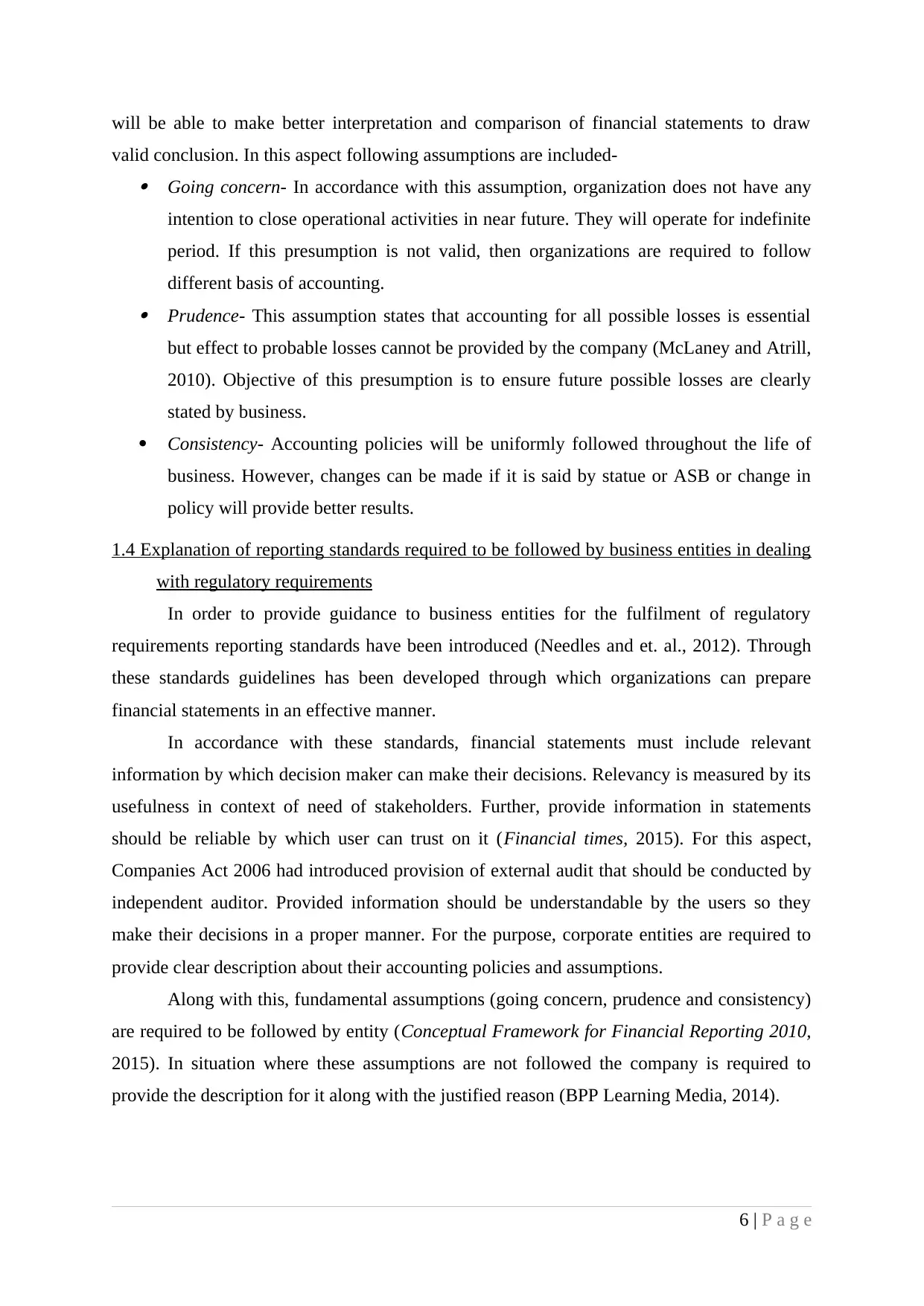
will be able to make better interpretation and comparison of financial statements to draw
valid conclusion. In this aspect following assumptions are included- Going concern- In accordance with this assumption, organization does not have any
intention to close operational activities in near future. They will operate for indefinite
period. If this presumption is not valid, then organizations are required to follow
different basis of accounting. Prudence- This assumption states that accounting for all possible losses is essential
but effect to probable losses cannot be provided by the company (McLaney and Atrill,
2010). Objective of this presumption is to ensure future possible losses are clearly
stated by business.
Consistency- Accounting policies will be uniformly followed throughout the life of
business. However, changes can be made if it is said by statue or ASB or change in
policy will provide better results.
1.4 Explanation of reporting standards required to be followed by business entities in dealing
with regulatory requirements
In order to provide guidance to business entities for the fulfilment of regulatory
requirements reporting standards have been introduced (Needles and et. al., 2012). Through
these standards guidelines has been developed through which organizations can prepare
financial statements in an effective manner.
In accordance with these standards, financial statements must include relevant
information by which decision maker can make their decisions. Relevancy is measured by its
usefulness in context of need of stakeholders. Further, provide information in statements
should be reliable by which user can trust on it (Financial times, 2015). For this aspect,
Companies Act 2006 had introduced provision of external audit that should be conducted by
independent auditor. Provided information should be understandable by the users so they
make their decisions in a proper manner. For the purpose, corporate entities are required to
provide clear description about their accounting policies and assumptions.
Along with this, fundamental assumptions (going concern, prudence and consistency)
are required to be followed by entity (Conceptual Framework for Financial Reporting 2010,
2015). In situation where these assumptions are not followed the company is required to
provide the description for it along with the justified reason (BPP Learning Media, 2014).
6 | P a g e
valid conclusion. In this aspect following assumptions are included- Going concern- In accordance with this assumption, organization does not have any
intention to close operational activities in near future. They will operate for indefinite
period. If this presumption is not valid, then organizations are required to follow
different basis of accounting. Prudence- This assumption states that accounting for all possible losses is essential
but effect to probable losses cannot be provided by the company (McLaney and Atrill,
2010). Objective of this presumption is to ensure future possible losses are clearly
stated by business.
Consistency- Accounting policies will be uniformly followed throughout the life of
business. However, changes can be made if it is said by statue or ASB or change in
policy will provide better results.
1.4 Explanation of reporting standards required to be followed by business entities in dealing
with regulatory requirements
In order to provide guidance to business entities for the fulfilment of regulatory
requirements reporting standards have been introduced (Needles and et. al., 2012). Through
these standards guidelines has been developed through which organizations can prepare
financial statements in an effective manner.
In accordance with these standards, financial statements must include relevant
information by which decision maker can make their decisions. Relevancy is measured by its
usefulness in context of need of stakeholders. Further, provide information in statements
should be reliable by which user can trust on it (Financial times, 2015). For this aspect,
Companies Act 2006 had introduced provision of external audit that should be conducted by
independent auditor. Provided information should be understandable by the users so they
make their decisions in a proper manner. For the purpose, corporate entities are required to
provide clear description about their accounting policies and assumptions.
Along with this, fundamental assumptions (going concern, prudence and consistency)
are required to be followed by entity (Conceptual Framework for Financial Reporting 2010,
2015). In situation where these assumptions are not followed the company is required to
provide the description for it along with the justified reason (BPP Learning Media, 2014).
6 | P a g e
⊘ This is a preview!⊘
Do you want full access?
Subscribe today to unlock all pages.

Trusted by 1+ million students worldwide
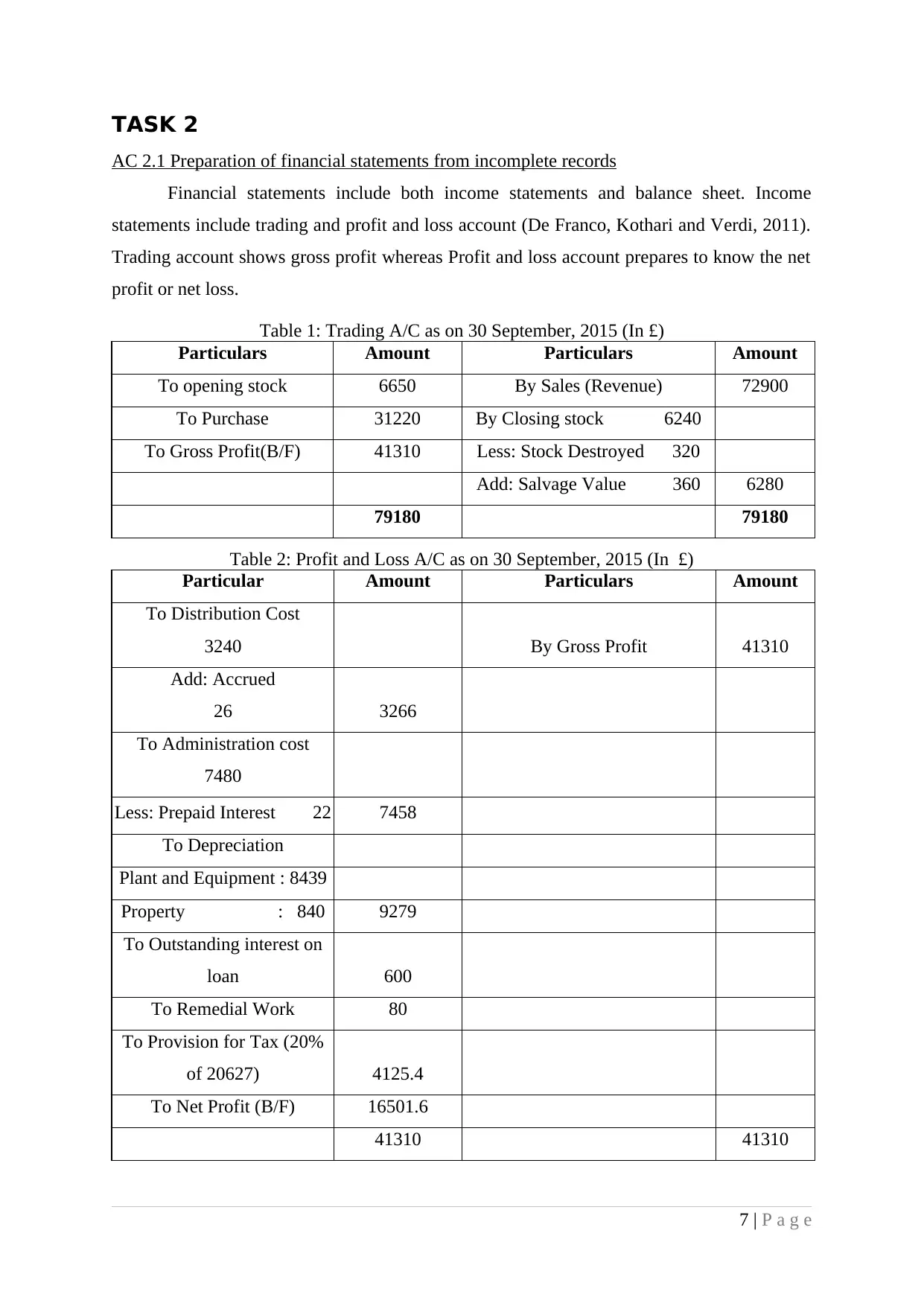
TASK 2
AC 2.1 Preparation of financial statements from incomplete records
Financial statements include both income statements and balance sheet. Income
statements include trading and profit and loss account (De Franco, Kothari and Verdi, 2011).
Trading account shows gross profit whereas Profit and loss account prepares to know the net
profit or net loss.
Table 1: Trading A/C as on 30 September, 2015 (In £)
Particulars Amount Particulars Amount
To opening stock 6650 By Sales (Revenue) 72900
To Purchase 31220 By Closing stock 6240
To Gross Profit(B/F) 41310 Less: Stock Destroyed 320
Add: Salvage Value 360 6280
79180 79180
Table 2: Profit and Loss A/C as on 30 September, 2015 (In £)
Particular Amount Particulars Amount
To Distribution Cost
3240 By Gross Profit 41310
Add: Accrued
26 3266
To Administration cost
7480
Less: Prepaid Interest 22 7458
To Depreciation
Plant and Equipment : 8439
Property : 840 9279
To Outstanding interest on
loan 600
To Remedial Work 80
To Provision for Tax (20%
of 20627) 4125.4
To Net Profit (B/F) 16501.6
41310 41310
7 | P a g e
AC 2.1 Preparation of financial statements from incomplete records
Financial statements include both income statements and balance sheet. Income
statements include trading and profit and loss account (De Franco, Kothari and Verdi, 2011).
Trading account shows gross profit whereas Profit and loss account prepares to know the net
profit or net loss.
Table 1: Trading A/C as on 30 September, 2015 (In £)
Particulars Amount Particulars Amount
To opening stock 6650 By Sales (Revenue) 72900
To Purchase 31220 By Closing stock 6240
To Gross Profit(B/F) 41310 Less: Stock Destroyed 320
Add: Salvage Value 360 6280
79180 79180
Table 2: Profit and Loss A/C as on 30 September, 2015 (In £)
Particular Amount Particulars Amount
To Distribution Cost
3240 By Gross Profit 41310
Add: Accrued
26 3266
To Administration cost
7480
Less: Prepaid Interest 22 7458
To Depreciation
Plant and Equipment : 8439
Property : 840 9279
To Outstanding interest on
loan 600
To Remedial Work 80
To Provision for Tax (20%
of 20627) 4125.4
To Net Profit (B/F) 16501.6
41310 41310
7 | P a g e
Paraphrase This Document
Need a fresh take? Get an instant paraphrase of this document with our AI Paraphraser
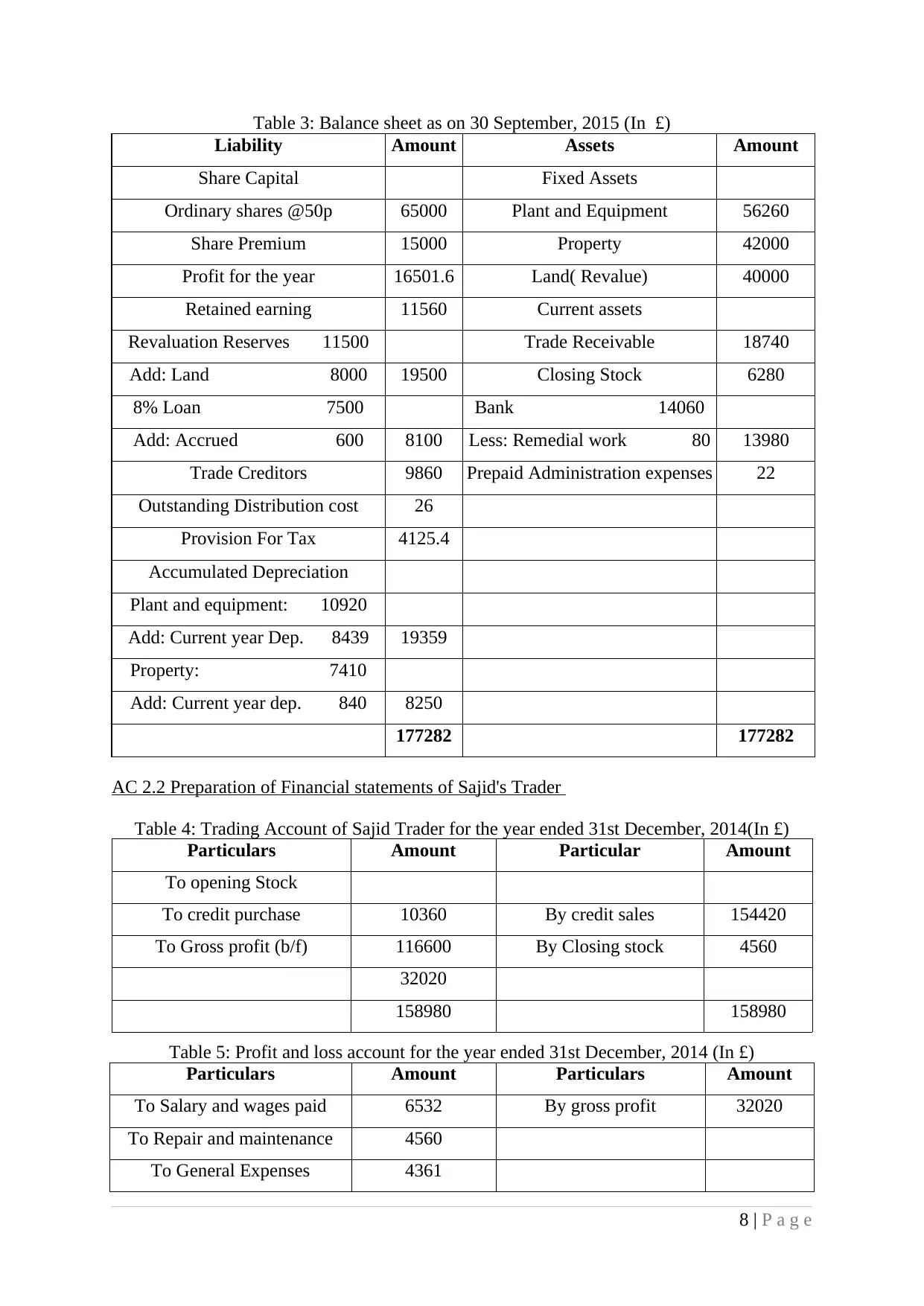
Table 3: Balance sheet as on 30 September, 2015 (In £)
Liability Amount Assets Amount
Share Capital Fixed Assets
Ordinary shares @50p 65000 Plant and Equipment 56260
Share Premium 15000 Property 42000
Profit for the year 16501.6 Land( Revalue) 40000
Retained earning 11560 Current assets
Revaluation Reserves 11500 Trade Receivable 18740
Add: Land 8000 19500 Closing Stock 6280
8% Loan 7500 Bank 14060
Add: Accrued 600 8100 Less: Remedial work 80 13980
Trade Creditors 9860 Prepaid Administration expenses 22
Outstanding Distribution cost 26
Provision For Tax 4125.4
Accumulated Depreciation
Plant and equipment: 10920
Add: Current year Dep. 8439 19359
Property: 7410
Add: Current year dep. 840 8250
177282 177282
AC 2.2 Preparation of Financial statements of Sajid's Trader
Table 4: Trading Account of Sajid Trader for the year ended 31st December, 2014(In £)
Particulars Amount Particular Amount
To opening Stock
To credit purchase 10360 By credit sales 154420
To Gross profit (b/f) 116600 By Closing stock 4560
32020
158980 158980
Table 5: Profit and loss account for the year ended 31st December, 2014 (In £)
Particulars Amount Particulars Amount
To Salary and wages paid 6532 By gross profit 32020
To Repair and maintenance 4560
To General Expenses 4361
8 | P a g e
Liability Amount Assets Amount
Share Capital Fixed Assets
Ordinary shares @50p 65000 Plant and Equipment 56260
Share Premium 15000 Property 42000
Profit for the year 16501.6 Land( Revalue) 40000
Retained earning 11560 Current assets
Revaluation Reserves 11500 Trade Receivable 18740
Add: Land 8000 19500 Closing Stock 6280
8% Loan 7500 Bank 14060
Add: Accrued 600 8100 Less: Remedial work 80 13980
Trade Creditors 9860 Prepaid Administration expenses 22
Outstanding Distribution cost 26
Provision For Tax 4125.4
Accumulated Depreciation
Plant and equipment: 10920
Add: Current year Dep. 8439 19359
Property: 7410
Add: Current year dep. 840 8250
177282 177282
AC 2.2 Preparation of Financial statements of Sajid's Trader
Table 4: Trading Account of Sajid Trader for the year ended 31st December, 2014(In £)
Particulars Amount Particular Amount
To opening Stock
To credit purchase 10360 By credit sales 154420
To Gross profit (b/f) 116600 By Closing stock 4560
32020
158980 158980
Table 5: Profit and loss account for the year ended 31st December, 2014 (In £)
Particulars Amount Particulars Amount
To Salary and wages paid 6532 By gross profit 32020
To Repair and maintenance 4560
To General Expenses 4361
8 | P a g e
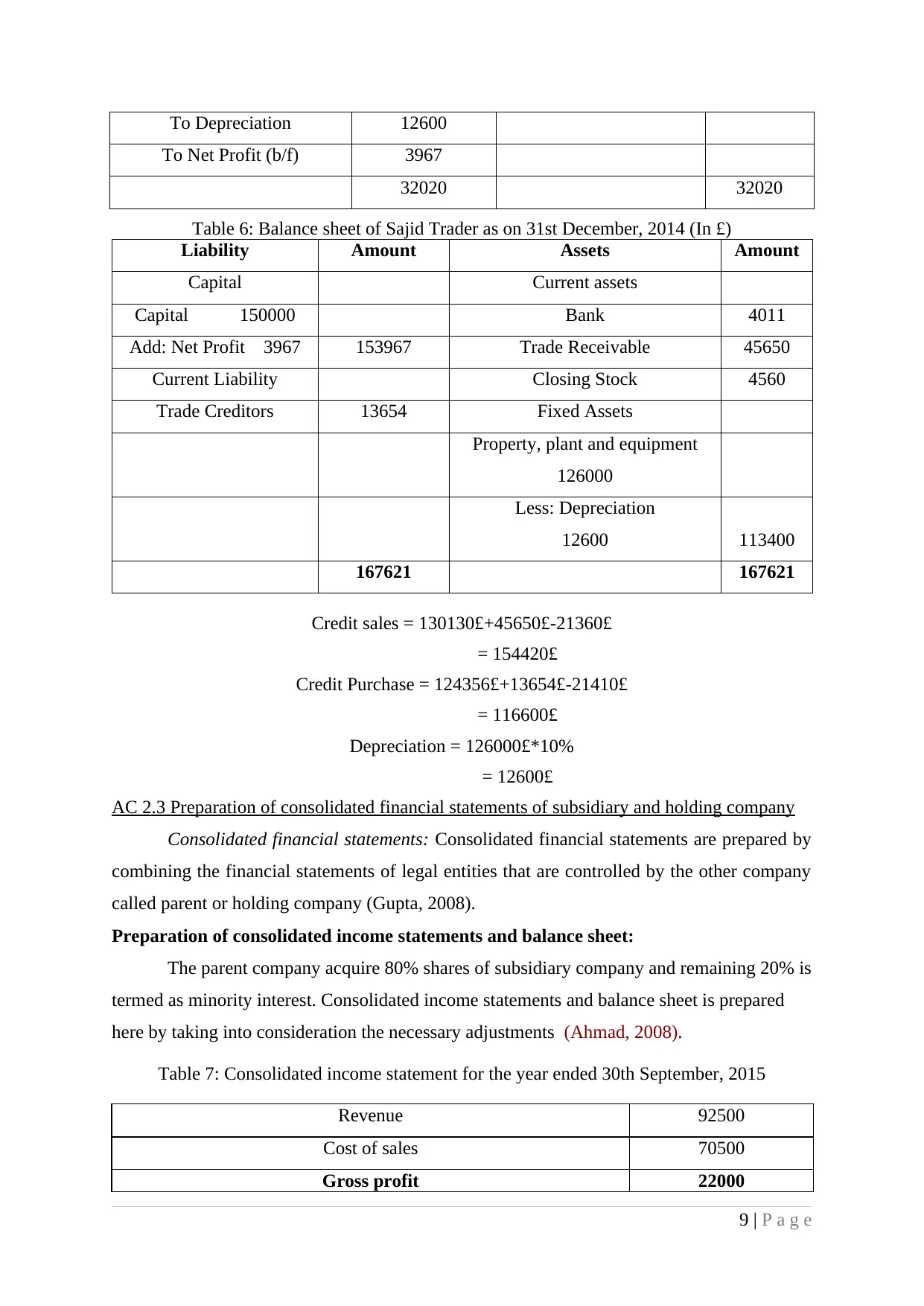
To Depreciation 12600
To Net Profit (b/f) 3967
32020 32020
Table 6: Balance sheet of Sajid Trader as on 31st December, 2014 (In £)
Liability Amount Assets Amount
Capital Current assets
Capital 150000 Bank 4011
Add: Net Profit 3967 153967 Trade Receivable 45650
Current Liability Closing Stock 4560
Trade Creditors 13654 Fixed Assets
Property, plant and equipment
126000
Less: Depreciation
12600 113400
167621 167621
Credit sales = 130130£+45650£-21360£
= 154420£
Credit Purchase = 124356£+13654£-21410£
= 116600£
Depreciation = 126000£*10%
= 12600£
AC 2.3 Preparation of consolidated financial statements of subsidiary and holding company
Consolidated financial statements: Consolidated financial statements are prepared by
combining the financial statements of legal entities that are controlled by the other company
called parent or holding company (Gupta, 2008).
Preparation of consolidated income statements and balance sheet:
The parent company acquire 80% shares of subsidiary company and remaining 20% is
termed as minority interest. Consolidated income statements and balance sheet is prepared
here by taking into consideration the necessary adjustments (Ahmad, 2008).
Table 7: Consolidated income statement for the year ended 30th September, 2015
Revenue 92500
Cost of sales 70500
Gross profit 22000
9 | P a g e
To Net Profit (b/f) 3967
32020 32020
Table 6: Balance sheet of Sajid Trader as on 31st December, 2014 (In £)
Liability Amount Assets Amount
Capital Current assets
Capital 150000 Bank 4011
Add: Net Profit 3967 153967 Trade Receivable 45650
Current Liability Closing Stock 4560
Trade Creditors 13654 Fixed Assets
Property, plant and equipment
126000
Less: Depreciation
12600 113400
167621 167621
Credit sales = 130130£+45650£-21360£
= 154420£
Credit Purchase = 124356£+13654£-21410£
= 116600£
Depreciation = 126000£*10%
= 12600£
AC 2.3 Preparation of consolidated financial statements of subsidiary and holding company
Consolidated financial statements: Consolidated financial statements are prepared by
combining the financial statements of legal entities that are controlled by the other company
called parent or holding company (Gupta, 2008).
Preparation of consolidated income statements and balance sheet:
The parent company acquire 80% shares of subsidiary company and remaining 20% is
termed as minority interest. Consolidated income statements and balance sheet is prepared
here by taking into consideration the necessary adjustments (Ahmad, 2008).
Table 7: Consolidated income statement for the year ended 30th September, 2015
Revenue 92500
Cost of sales 70500
Gross profit 22000
9 | P a g e
⊘ This is a preview!⊘
Do you want full access?
Subscribe today to unlock all pages.

Trusted by 1+ million students worldwide
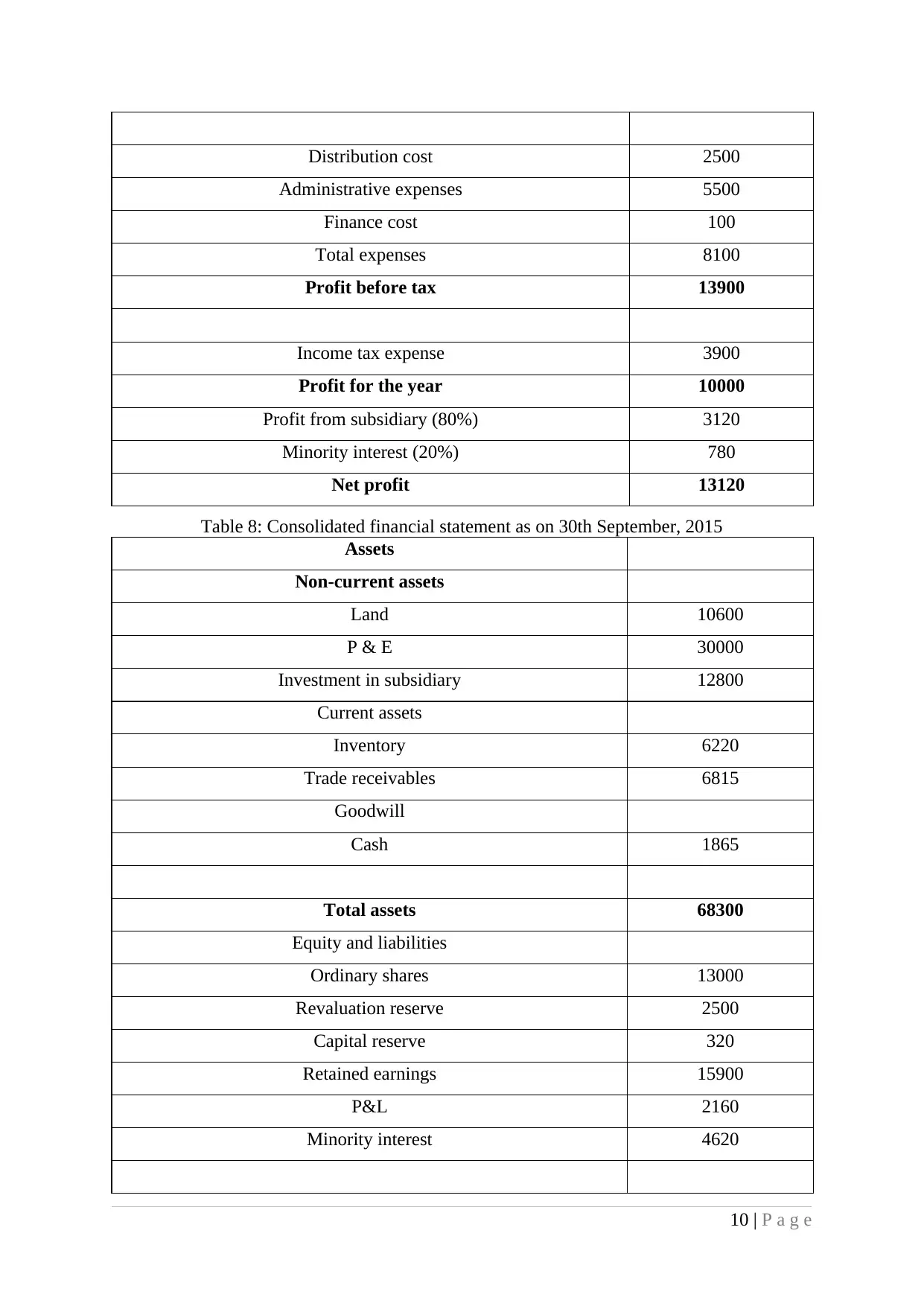
Distribution cost 2500
Administrative expenses 5500
Finance cost 100
Total expenses 8100
Profit before tax 13900
Income tax expense 3900
Profit for the year 10000
Profit from subsidiary (80%) 3120
Minority interest (20%) 780
Net profit 13120
Table 8: Consolidated financial statement as on 30th September, 2015
Assets
Non-current assets
Land 10600
P & E 30000
Investment in subsidiary 12800
Current assets
Inventory 6220
Trade receivables 6815
Goodwill
Cash 1865
Total assets 68300
Equity and liabilities
Ordinary shares 13000
Revaluation reserve 2500
Capital reserve 320
Retained earnings 15900
P&L 2160
Minority interest 4620
10 | P a g e
Administrative expenses 5500
Finance cost 100
Total expenses 8100
Profit before tax 13900
Income tax expense 3900
Profit for the year 10000
Profit from subsidiary (80%) 3120
Minority interest (20%) 780
Net profit 13120
Table 8: Consolidated financial statement as on 30th September, 2015
Assets
Non-current assets
Land 10600
P & E 30000
Investment in subsidiary 12800
Current assets
Inventory 6220
Trade receivables 6815
Goodwill
Cash 1865
Total assets 68300
Equity and liabilities
Ordinary shares 13000
Revaluation reserve 2500
Capital reserve 320
Retained earnings 15900
P&L 2160
Minority interest 4620
10 | P a g e
Paraphrase This Document
Need a fresh take? Get an instant paraphrase of this document with our AI Paraphraser
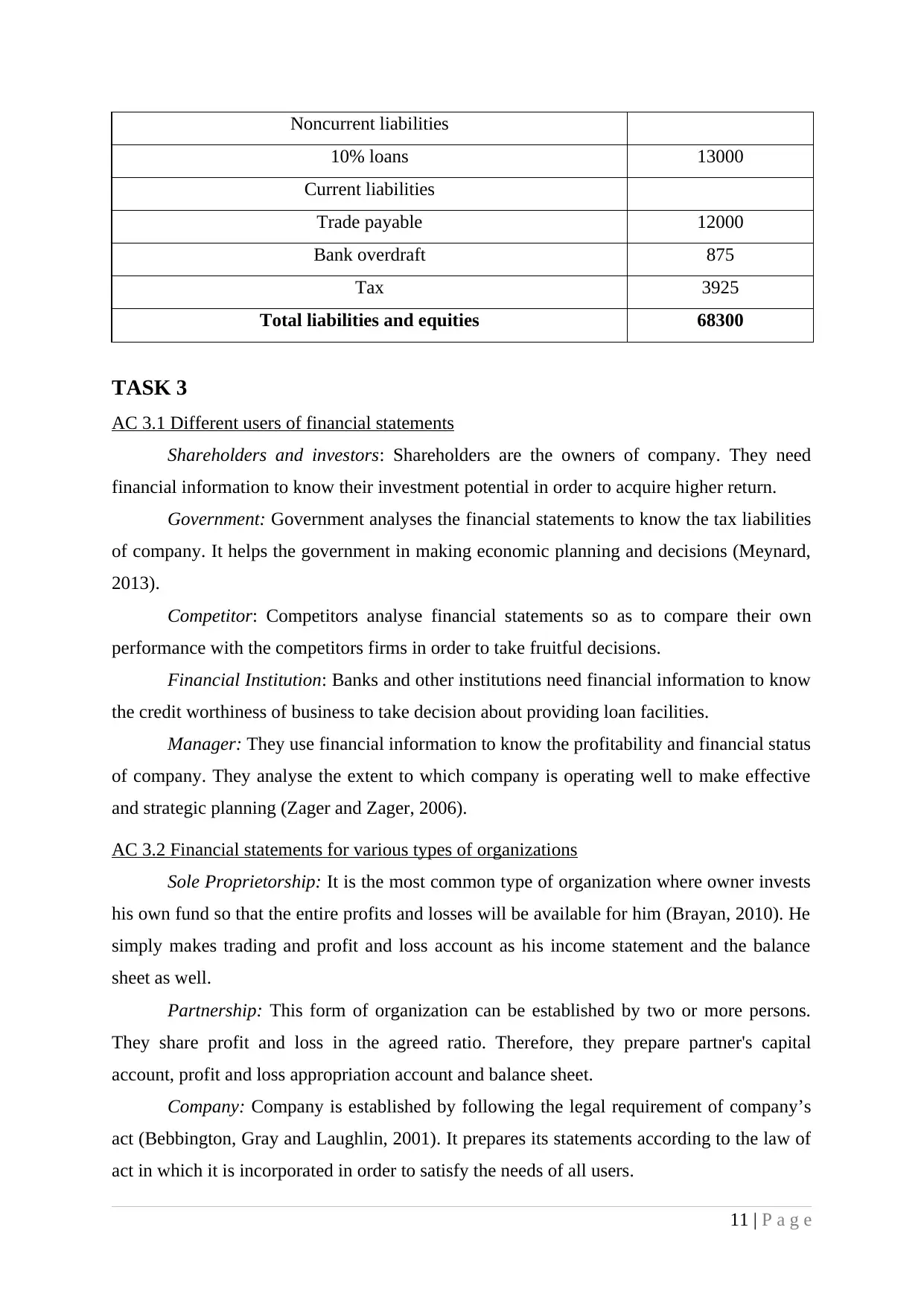
Noncurrent liabilities
10% loans 13000
Current liabilities
Trade payable 12000
Bank overdraft 875
Tax 3925
Total liabilities and equities 68300
TASK 3
AC 3.1 Different users of financial statements
Shareholders and investors: Shareholders are the owners of company. They need
financial information to know their investment potential in order to acquire higher return.
Government: Government analyses the financial statements to know the tax liabilities
of company. It helps the government in making economic planning and decisions (Meynard,
2013).
Competitor: Competitors analyse financial statements so as to compare their own
performance with the competitors firms in order to take fruitful decisions.
Financial Institution: Banks and other institutions need financial information to know
the credit worthiness of business to take decision about providing loan facilities.
Manager: They use financial information to know the profitability and financial status
of company. They analyse the extent to which company is operating well to make effective
and strategic planning (Zager and Zager, 2006).
AC 3.2 Financial statements for various types of organizations
Sole Proprietorship: It is the most common type of organization where owner invests
his own fund so that the entire profits and losses will be available for him (Brayan, 2010). He
simply makes trading and profit and loss account as his income statement and the balance
sheet as well.
Partnership: This form of organization can be established by two or more persons.
They share profit and loss in the agreed ratio. Therefore, they prepare partner's capital
account, profit and loss appropriation account and balance sheet.
Company: Company is established by following the legal requirement of company’s
act (Bebbington, Gray and Laughlin, 2001). It prepares its statements according to the law of
act in which it is incorporated in order to satisfy the needs of all users.
11 | P a g e
10% loans 13000
Current liabilities
Trade payable 12000
Bank overdraft 875
Tax 3925
Total liabilities and equities 68300
TASK 3
AC 3.1 Different users of financial statements
Shareholders and investors: Shareholders are the owners of company. They need
financial information to know their investment potential in order to acquire higher return.
Government: Government analyses the financial statements to know the tax liabilities
of company. It helps the government in making economic planning and decisions (Meynard,
2013).
Competitor: Competitors analyse financial statements so as to compare their own
performance with the competitors firms in order to take fruitful decisions.
Financial Institution: Banks and other institutions need financial information to know
the credit worthiness of business to take decision about providing loan facilities.
Manager: They use financial information to know the profitability and financial status
of company. They analyse the extent to which company is operating well to make effective
and strategic planning (Zager and Zager, 2006).
AC 3.2 Financial statements for various types of organizations
Sole Proprietorship: It is the most common type of organization where owner invests
his own fund so that the entire profits and losses will be available for him (Brayan, 2010). He
simply makes trading and profit and loss account as his income statement and the balance
sheet as well.
Partnership: This form of organization can be established by two or more persons.
They share profit and loss in the agreed ratio. Therefore, they prepare partner's capital
account, profit and loss appropriation account and balance sheet.
Company: Company is established by following the legal requirement of company’s
act (Bebbington, Gray and Laughlin, 2001). It prepares its statements according to the law of
act in which it is incorporated in order to satisfy the needs of all users.
11 | P a g e
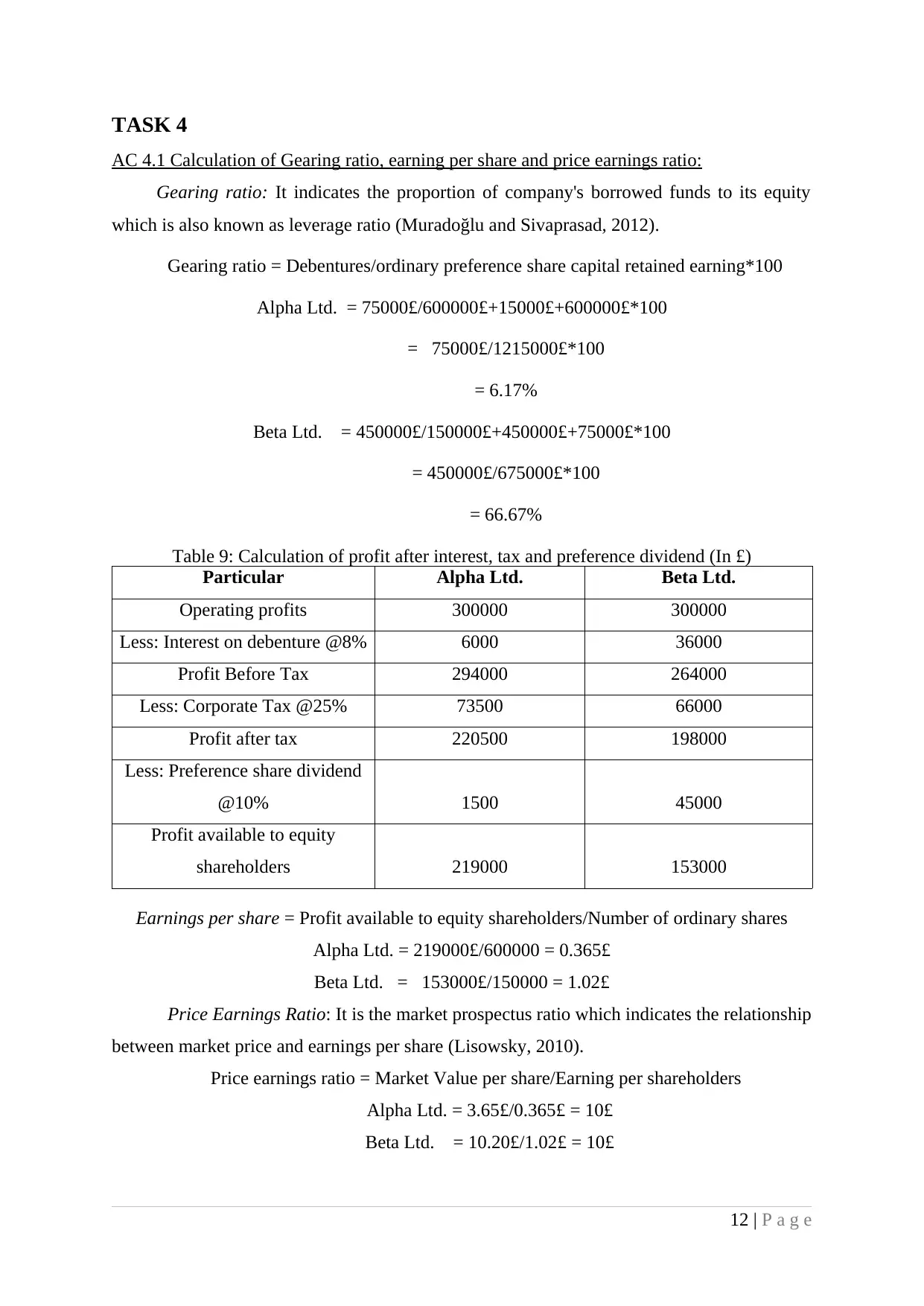
TASK 4
AC 4.1 Calculation of Gearing ratio, earning per share and price earnings ratio:
Gearing ratio: It indicates the proportion of company's borrowed funds to its equity
which is also known as leverage ratio (Muradoğlu and Sivaprasad, 2012).
Gearing ratio = Debentures/ordinary preference share capital retained earning*100
Alpha Ltd. = 75000£/600000£+15000£+600000£*100
= 75000£/1215000£*100
= 6.17%
Beta Ltd. = 450000£/150000£+450000£+75000£*100
= 450000£/675000£*100
= 66.67%
Table 9: Calculation of profit after interest, tax and preference dividend (In £)
Particular Alpha Ltd. Beta Ltd.
Operating profits 300000 300000
Less: Interest on debenture @8% 6000 36000
Profit Before Tax 294000 264000
Less: Corporate Tax @25% 73500 66000
Profit after tax 220500 198000
Less: Preference share dividend
@10% 1500 45000
Profit available to equity
shareholders 219000 153000
Earnings per share = Profit available to equity shareholders/Number of ordinary shares
Alpha Ltd. = 219000£/600000 = 0.365£
Beta Ltd. = 153000£/150000 = 1.02£
Price Earnings Ratio: It is the market prospectus ratio which indicates the relationship
between market price and earnings per share (Lisowsky, 2010).
Price earnings ratio = Market Value per share/Earning per shareholders
Alpha Ltd. = 3.65£/0.365£ = 10£
Beta Ltd. = 10.20£/1.02£ = 10£
12 | P a g e
AC 4.1 Calculation of Gearing ratio, earning per share and price earnings ratio:
Gearing ratio: It indicates the proportion of company's borrowed funds to its equity
which is also known as leverage ratio (Muradoğlu and Sivaprasad, 2012).
Gearing ratio = Debentures/ordinary preference share capital retained earning*100
Alpha Ltd. = 75000£/600000£+15000£+600000£*100
= 75000£/1215000£*100
= 6.17%
Beta Ltd. = 450000£/150000£+450000£+75000£*100
= 450000£/675000£*100
= 66.67%
Table 9: Calculation of profit after interest, tax and preference dividend (In £)
Particular Alpha Ltd. Beta Ltd.
Operating profits 300000 300000
Less: Interest on debenture @8% 6000 36000
Profit Before Tax 294000 264000
Less: Corporate Tax @25% 73500 66000
Profit after tax 220500 198000
Less: Preference share dividend
@10% 1500 45000
Profit available to equity
shareholders 219000 153000
Earnings per share = Profit available to equity shareholders/Number of ordinary shares
Alpha Ltd. = 219000£/600000 = 0.365£
Beta Ltd. = 153000£/150000 = 1.02£
Price Earnings Ratio: It is the market prospectus ratio which indicates the relationship
between market price and earnings per share (Lisowsky, 2010).
Price earnings ratio = Market Value per share/Earning per shareholders
Alpha Ltd. = 3.65£/0.365£ = 10£
Beta Ltd. = 10.20£/1.02£ = 10£
12 | P a g e
⊘ This is a preview!⊘
Do you want full access?
Subscribe today to unlock all pages.

Trusted by 1+ million students worldwide
1 out of 13
Related Documents
Your All-in-One AI-Powered Toolkit for Academic Success.
+13062052269
info@desklib.com
Available 24*7 on WhatsApp / Email
![[object Object]](/_next/static/media/star-bottom.7253800d.svg)
Unlock your academic potential
Copyright © 2020–2025 A2Z Services. All Rights Reserved. Developed and managed by ZUCOL.




